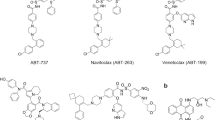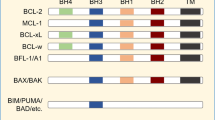Abstract
A novel small molecule inhibitor, 4-(3-methoxy-phenylsulfannyl)-7-nitro-benzofurazan-3-oxide (MNB), competes with the Bak BH3 peptide to bind Bcl-2 protein with a binding affinity of IC50 = 0.70 μM, as assessed by a fluorescence polarization based binding assay. HL-60 cells express the highest levels of Bcl-2 among the cell lines examined. Treated with 5 μM of MNB only for 6 h, 85% of HL-60 cells were detected to undergo apoptosis. Pan-caspase inhibitor, Z-VAD-FMK, blocks MNB-induced apoptosis in HL-60 cells. Caspase-2, caspase-3, caspase-7, caspase-8, caspase-9, and PARP activation were observed at as early as 4 to 6 h of MNB treatment. In addition, it has been confirmed that the caspase-3 specific inhibitor, Z-DEVD-FMK, blocks the activation of caspase-8 in MNB-treated HL-60 cells. MNB treatment does not change Bcl-2 or Bax expression level in HL-60 cells, but causes Bid cleavage. Further experiments have illustrated that MNB inhibits the heterodimerization of Bcl-2 with Bax or Bid, reduces the mitochondrial membrane potential (ΔΨmt), and induces cytochrome c release from mitochondria in HL-60 cells. These results suggest that MNB induces apoptosis in HL-60 by inhibiting the heterodimerization of Bcl-2 with pro-apoptosis Bcl-2 members, resulting in a decrease in the mitochondrial membrane potential and cytochrome c release, activation of caspases and PARP; it is a caspase-dependent process in which the activation of caspase-8 is dependent on the mitochondrial apoptosis signal transduction pathway. MNB prolongs the life spans of HL-60 bearing mice, potently kills fresh AML and ALL cells, indicating that it has the potential to be developed to treat leukemia.






Similar content being viewed by others
References
Haarman EG, Kaspers GJ, Pieters R, van Zantwijk CH, Broekema GJ, Hahlen K, Veerman AJ (1999) BCL-2 expression in childhood leukemia versus spontaneous apoptosis, drug induced apoptosis, and in vitro drug resistance. Adv Exp Med Biol 457:325–333
Del Principe MI, Del Poeta G, Venditti A, Buccisano F, Maurillo L, Mazzone C, Bruno A, Neri B, Irno Consalvo M, Lo Coco F, Amadori S (2005) Apoptosis and immaturity in acute myeloid leukemia. Hematology 10:25–34
Campos L, Sabido O, Viallet A, Vasselon C, Guyotat D (1999) Expression of apoptosis-controlling proteins in acute leukemia cells. Leuk Lymphoma 33:499–509
Coustan-Smith E, Kitanaka A, Pui CH, McNinch L, Evans WE, Raimondi SC, Behm FG, Arico M, Campana D (1996) Clinical relevance of BCL-2 overexpression in childhood acute lymphoblastic leukemia. Blood 87:1140–1146
Salomons GS, Smets LA, Verwijs-Janssen M, Hart AA, Haarman EG, Kaspers GJ, Wering EV, Der Does-Van Den Berg AV, Kamps WA (1999) Bcl-2 family members in childhood acute lymphoblastic leukemia: relationships with features at presentation, in vitro and in vivo drug response and long-term clinical outcome. Leukemia 13:1574–1580
Klumper E, Pieters R, Veerman AJ, Huismans DR, Loonen AH, Hahlen K, Kaspers GJ, van Wering ER, Hartmann R, Henze G (1995) In vitro cellular drug resistance in children with relapsed/refractory acute lymphoblastic leukemia. Blood 86:3861–3868
Majlessipour F, Avramis IA, Kwock R, Weinberg KI, Avrami VI (2002) The combination regimen of idarubicin and taxotere is effective against human drug-resistant leukemic cell lines. Anticancer Res 22:1361–1368
Reed JC, Pellecchia M (2005) Apoptosis-based therapies for hematologic malignancies. Blood 106:408–418
Burger H, Nooter K, Boersma AW, Kortland CJ, Stoter G (1997) Lack of correlation between cisplatin-induced apoptosis, p53 status and expression of Bcl-2 family proteins in testicular germ cell tumour cell lines. Int J Cancer 73:592–599
Houldsworth J, Xiao H, Murty VV, Chen W, Ray B, Reuter VE, Bosl GJ, Chaganti RS (1998) Human male germ cell tumor resistance to cisplatin is linked to TP53 gene mutation. Oncogene 16:2345–2349
Campos L, Sabido O, Liang H, Vasselon C, Guyotat D (1996) Expression of human Bcl-xL, an inhibitor of programmed cell death. Nature 33:335–341
Holinger EP, Chittenden T, Lutz RJ (1999) Bak BH3 peptides antagonize Bcl-xL function and induce apoptosis through cytochrome c-independent activation of caspases. J Biol Chem 274:13298–13304
Finnegan NM, Curtin JF, Prevost G, Morgan B, Cotter TG (2001) Induction of apoptosis in prostate carcinoma cells by BH3 peptides which inhibit Bak/Bcl-2 interactions. Br J Cancer 85:115–121
Shangary S, Johnson DE (2002) Peptides derived from BH3 domains of Bcl-2 family members: a comparative analysis of inhibition of Bcl-2, Bcl-x(L) and Bax oligomerization, induction of cytochrome c release, and activation of cell death. Biochemistry 41:9485–9495
Wang JL, Liu D, Zhang ZJ, Shan S, Han X, Srinivasula SM, Croce CM, Alnemri ES, Huang Z (2000) Structure-based discovery of an organic compound that binds Bcl-2 protein and induces apoptosis of tumor cells. Proc Natl Acad Sci U S A 97:7124–7129
Degterev A, Lugovskoy A, Cardone M, Mulley B, Wagner G, Mitchison T, Yuan J (2001) Identification of small-molecule inhibitors of interaction between the BH3 domain and Bcl-xL. Nat Cell Biol 3:173–182
Tzung SP, Kim KM, Basanez G, Giedt CD, Simon J, Zimmerberg J, Zhang KY, Hockenbery DM (2001) Antimycin A mimics a cell-death-inducing Bcl-2 homology domain 3. Nat Cell Biol 3:183–191
Enyedy IJ, Ling Y, Nacro K, Tomita Y, Wu X, Cao Y, Guo R, Li B, Zhu X, Huang Y, Long YQ, Roller PP, Yang D, Wang S (2001) Discovery of small-molecule inhibitors of Bcl-2 through structure-based computer screening. J Med Chem 44:4313–4324
Oltersdorf T, Elmore SW, Shoemaker AR, Armstrong RC, Augeri DJ, Belli BA, Bruncko M, Deckwerth TL, Dinges J, Hajduk PJ, Joseph MK, Kitada S, Korsmeyer SJ, Kunzer AR, Letai A, Li C, Mitten MJ, Nettesheim DG, Ng S, Nimmer PM, O’Connor JM, Oleksijew A, Petros AM, Reed JC, Shen W, Tahir SK, Thompson CB, Tomaselli KJ, Wang B, Wendt MD, Zhang H, Fesik SW, Rosenberg SH (2005) An inhibitor of Bcl-2 family proteins induces regression of solid tumours. Nature 435:677–681
Manion MK, Fry J, Schwartz PS, Hockenbery DM (2006) Small-molecule inhibitors of Bcl-2. Curr Opin Investig Drugs 7:1077–1084
Mohammad RM, Mohamed AN, Smith MR, Jawadi NS, al-Katib A (1993) A unique EBV-negative low-grade lymphoma line (WSU-FSCCL) exhibiting both t(14;18) and t(8;11). Cancer Genet Cytogenet 70:62–67
Gloeckner H, Jonuleit T, Lemke HD (2001) Monitoring of cell viability and cell growth in a hollow-fiber bioreactor by use of the dye Alamar Blue. J Immunol Methods 252:131–138
Hsu YT, Youle RJ (1998) Bax in murine thymus is a soluble monomeric protein that displays differential detergent-induced conformations. J Biol Chem 273:10777–10783
Hong C, Kim HA, Firestone GL, Bjeldanes LF (2002) 3,3′-Diindolylmethane (DIM) induces a G(1) cell cycle arrest in human breast cancer cells that is accompanied by Sp1-mediated activation of p21(WAF1/CIP1) expression. Carcinogenesis 23:1297–1305
Dewson G, Snowden RT, Almond JB, Dyer MJ, Cohen GM (2003) Conformational change and mitochondrial translocation of Bax accompany proteasome inhibitor-induced apoptosis of chronic lymphocytic leukemic cells. Oncogene 22:2643–2654
Petros AM, Medek A, Nettesheim DG, Kim DH, Yoon HS, Swift K, Matayoshi ED, Oltersdorf T, Fesik SW (2001) Solution structure of the antiapoptotic protein bcl-2. Proc Natl Acad Sci U S A 98:3012–3017
Ozgen U, Savasan S, Buck S, Ravindranath Y (2000) Comparison of DiOC(6)(3) uptake and annexin V labeling for quantification of apoptosis in leukemia cells and non-malignant T lymphocytes from children. Cytometry 42:74–78
Saleh A, Srinivasula SM, Acharya S, Fishel R, Alnemri ES (1999) Cytochrome c and dATP-mediated oligomerization of Apaf-1 is a prerequisite for procaspase-9 activation. J Biol Chem 274:17941–17945
Goodsell DS, Morris GM, Olson AJ (1996) Automated docking of flexible ligands: applications of AutoDock. J Mol Recognit 9:1–5
Wieder T, Essmann F, Prokop A, Schmelz K, Schulze-Osthoff K, Beyaert R, Dorken B, Daniel PT (2001) Activation of caspase-8 in drug-induced apoptosis of B-lymphoid cells is independent of CD95/Fas receptor-ligand interaction and occurs downstream of caspase-3. Blood 97:1378–1387
Daniel PT, Wieder T, Sturm I, Schulze-Osthoff K (2001) The kiss of death: promises and failures of death receptors and ligands in cancer therapy. Leukemia 15:1022–1032
von Haefen C, Wieder T, Essmann F, Schulze-Osthoff K, Dorken B, Daniel PT (2003) Paclitaxel-induced apoptosis in BJAB cells proceeds via a death receptor-independent, caspases-3/-8-driven mitochondrial amplification loop. Oncogene 22:2236–2247
Ly JD, Grubb DR, Lawen A (2003) The mitochondrial membrane potential (deltapsi(m)) in apoptosis; an update. Apoptosis 8:115–128
Kluck RM, Bossy-Wetzel E, Green DR, Newmeyer DD (1997) The release of cytochrome c from mitochondria: a primary site for Bcl-2 regulation of apoptosis. Science 275:1132–1136
Pan MH, Chang WL, Lin-Shiau SY, Ho CT, Lin JK (2001) Induction of apoptosis by garcinol and curcumin through cytochrome c release and activation of caspases in human leukemia HL-60 cells. J Agric Food Chem 49:1464–1474
Lee SH, Ryu SY, Kim HB, Kim MY Chun YJ (2002) Induction of apoptosis by 3,4′-dimethoxy-5-hydroxystilbene in human promyeloid leukemic HL-60 cells. Planta Med 68:123–127
Kim JH, Ju EM, Lee DK, Hwang HJ (2002) Induction of apoptosis by momordin I in promyelocytic leukemia (HL-60) cells. Anticancer Res 22:1885–1889
Hattori T, Ookawa N, Fujita R, Fukuchi K (2000) Heterodimerization of Bcl-2 and Bcl-X(L) with Bax and Bad in colorectal cancer. Acta Oncol 39:495–500
Hirotani M, Zhang Y, Fujita N, Naito M, Tsuruo T (1999) NH2-terminal BH4 domain of Bcl-2 is functional for heterodimerization with Bax and inhibition of apoptosis. J Biol Chem 274:20415–20420
St Clair EG, Anderson SJ, Oltvai ZN (1997) Bcl-2 counters apoptosis by Bax heterodimerization-dependent and -independent mechanisms in the T-cell lineage. J Biol Chem 272:29347–29355
Zha H, Aime-Sempe C, Sato T, Reed JC (1996) Proapoptotic protein Bax heterodimerizes with Bcl-2 and homodimerizes with Bax via a novel domain (BH3) distinct from BH1 and BH2. J Biol Chem 271:7440–7444
Dirsch VM, Antlsperger DS, Hentze H, Vollmar AM (2002) Ajoene, an experimental anti-leukemic drug: mechanism of cell death. Leukemia 16:74–83
Becattini B, Culmsee C, Leone M, Zhai D, Zhang X, Crowell KJ, Rega MF, Landshamer S, Reed JC, Plesnila N, Pellecchia M (2006) Structure–activity relationships by interligand NOE-based design and synthesis of antiapoptotic compounds targeting Bid. Proc Natl Acad Sci U S A 103:12602–12606
Ward MW, Rehm M, Duessmann H, Kacmar S, Concannon CG, Prehn JH (2006) Real time single cell analysis of Bid cleavage and Bid translocation during caspase-dependent and neuronal caspase-independent apoptosis. J Biol Chem 281:5837–5844
Kumar S, Vaux DL (2002) Apoptosis. A cinderella caspase takes center stage. Science 297:1290–1291
Lassus P, Opitz-Araya X, Lazebnik Y (2002) Requirement for caspase-2 in stress-induced apoptosis before mitochondrial permeabilization. Science 297:1352–1354
Marsden VS, O’Connor L, O’Reilly LA, Silke J, Metcalf D, Ekert PG, Huang DC, Cecconi F, Kuida K, Tomaselli KJ, Roy S, Nicholson DW, Vaux DL, Bouillet P, Adams JM, Strasser A (2002) Apoptosis initiated by Bcl-2-regulated caspase activation independently of the cytochrome c/Apaf-1/caspase-9 apoptosome. Nature 419:634–637
Goldie JH, Coldman AJ (1984) The genetic origin of drug resistance in neoplasms: implications for systemic therapy. Cancer Res 44:3643–3653
Acknowledgements
This work was supported in part by Department of Defense. The authors thank Dr. Karen Cresewell of the Lombardi Cancer Center, Georgetown University for operating FACScan and Ms. Karen Kreutzer of the University of Michigan Medical School for proofreading the original manuscript.
Author information
Authors and Affiliations
Corresponding author
Rights and permissions
About this article
Cite this article
Zhang, M., Ling, Y., Yang, CY. et al. A novel Bcl-2 small molecule inhibitor 4-(3-methoxy-phenylsulfannyl)-7-nitro-benzofurazan-3-oxide (MNB)-induced apoptosis in leukemia cells. Ann Hematol 86, 471–481 (2007). https://doi.org/10.1007/s00277-007-0288-4
Received:
Accepted:
Published:
Issue Date:
DOI: https://doi.org/10.1007/s00277-007-0288-4




